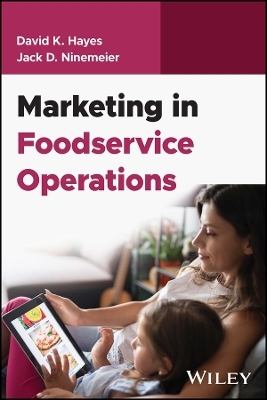
Marketing in Foodservice Operations
John Wiley & Sons Inc (Verlag)
978-1-394-20833-3 (ISBN)
- Titel z.Zt. nicht lieferbar
- Versandkostenfrei innerhalb Deutschlands
- Auch auf Rechnung
- Verfügbarkeit in der Filiale vor Ort prüfen
- Artikel merken
In Marketing in Foodservice Operations, a team of distinguished foodservice educators and practitioners delivers an insightful and practical exploration of contemporary foodservice marketing. Capturing the wide range of dramatic changes that have gripped the discipline in the last two decades, the book discusses basic marketing information and includes a heavy emphasis on modern forms of digital marketing in the industry.
Learn how to identify a target market and create a marketing plan, as well as how menu prices impact an organization’s marketing. The authors also describe how to use a foodservice operation’s menu as a marketing tool and consider the importance of an active social media presence visible to the target market. Other contents include:
A complete introduction to the development, implementation, and evaluation of a foodservice marketing plan
Comprehensive explorations of traditional and contemporary foodservice marketing strategies
Practical discussions of digital foodservice marketing techniques, including social media plans
Insightful treatments of mobile-friendly marketing strategies
Perfect for students in foodservice-related courses, Marketing in Foodservice Operations will also benefit foodservice establishment owners and operators and professionals working in colleges, hospitals, nursing homes, and more.
David Hayes, PhD, has taught hospitality courses at Purdue University, Texas Tech University, The University of Houston, and Lansing Community College. He has served as the Vice President of Broadcast and Video Training for the American Hotel & Lodging Educational Institute. Jack Ninemeier, PhD, is an Emeritus Professor in the School of Hospitality Business at Michigan State University. He has many years’ experience developing and providing training and resource materials for commercial and non-commercial foodservice operations. He has also written several hundred articles for trade journals and created training monographs. Part of Wiley’s Foodservice Operations: The Essentials series.
Preface ix
Acknowledgments xiii
Dedication xv
1 Marketing for Foodservice Operations 1
The Importance of Marketing 2
Who 3
What 4
Where 4
When 5
How 5
The 4 Ps of Marketing 5
Product 6
Place 7
Price 8
Promotion 9
Operators’ Challenges in Marketing Products 11
Quality 11
Quantity 12
Delivery Method 12
Value Perception 13
Operators’ Challenges in Marketing Services 14
Intangibility 15
Inseparability 15
Consistency 16
Limited Capacity 17
2 Target Market Identification 21
The Importance of Target Market Identification 22
Why Target Markets Must Be Identified 23
How Target Markets Are Identified 24
Identifying the Needs of a Target Market 29
Internal Factors Affecting Target Markets 33
Physical Facilities 33
Staff Capabilities 35
External Factors Affecting Target Markets 38
The Economic Environment 38
Legal Requirements 39
Vendor and Product Availability 40
The Competitive Environment 40
The Social Environment 42
Technology 43
3 Creating the Marketing Message 48
The Marketing Message and Importance of Branding 49
The Marketing Message 50
Branding Defined 50
Developing a Unique Brand 51
Product-Focused Branding 54
Service-Focused Branding 54
Factors Affecting Product- Related Messages 55
Product Quality 56
Preparation Method 58
Serving Size 58
Price 59
Convenience 61
Location 62
Service Offering Messages by Type of Operation 64
Non-Commercial Operations 65
Quick Service Restaurants (QSRs) 66
Fast Casual Restaurants 66
Casual Service Restaurants 67
Fine Dining/Upscale Restaurants 68
Ghost Operations 69
4 Delivering the Marketing Message 72
Assessing Marketing Channels 73
Marketing Channel Options 73
Assessing New Communication Channels 81
Understanding Buyer Behavior 83
The Four Buyer Types 83
Buyer Behavior 86
Operator Responsibilities in Target Market Messaging 88
Legal Responsibilities 89
Ethical Responsibilities 90
Social Responsibilities 91
5 Creating the Marketing Plan 95
The Need for a Written Marketing Plan 96
Advantages of Developing a Formal Marketing Plan 98
Challenges in Marketing Plan Development 99
Creating the Marketing Plan 101
Identification of Marketing Strategies 104
Identification of Marketing Tactics 106
Creation of Marketing Plan Cost Estimates 108
Implementing the Marketing Plan 109
Determining What Will Be Done 109
Determining When It Will Be Done 110
Determining Who Will Do It 110
Importance of Staff Efforts to Implement Marketing Plans 111
Evaluation of Marketing Plan Results 115
6 The Importance of Price in Marketing Efforts 119
Pricing for Profits 120
The Importance of Pricing 121
The Operator’s View of Price 121
The Guest’s View of Price 122
Factors Affecting Menu Pricing 124
Economic Conditions 124
Local Competition 125
Level of Service 125
Type of Guest 126
Product Quality 126
Portion Size 127
Delivery Method 128
Meal Period 129
Location 129
Bundling 130
Methods of Food and Beverage Pricing 131
Cost-Based Pricing 132
Contribution Margin- Based Pricing 135
Evaluation of Pricing Efforts 137
Menu Engineering 137
Menu Modifications 141
7 The Menu as a Marketing Tool 145
The Importance of the Menu 146
The Menu as a Marketing Tool 147
Types of Menus 147
The Menu Development Team 149
Legal Aspects of Menu Design 149
Creating the Food Menu 151
Identifying Menu Categories 152
Selecting Individual Menu Items 153
Writing Menu Copy 154
Key Factors in Successful Food Menu Design 155
Creating the Beverage Menu 157
Beer Menus 157
Wine Lists 158
Spirit Menus 159
Digital Display Menus 162
On-site Digital Menus 162
On-user Device Digital Menus 163
Special Concerns for Off- Premise Menus 165
Choosing Takeaway Menu Items 166
Packaging Takeaway Menu Items 166
Holding Takeaway Menu Items for Pickup or Delivery 168
8 Importance of the Foodservice Marketing Mix 172
Advertising 173
The Purpose of Advertising 174
Developing the Advertising Message 176
Determining the Best Message Delivery Channel 178
Personal Selling 179
The Goals of In- person Selling 180
On-Premise Personal Selling 181
Off-Premise Personal Selling 182
Promotions 183
The Purpose of Promotions 183
Promotions for All Customers 184
Promotions for Loyal Customers 185
Publicity 187
Initiating Positive Publicity 187
Addressing Negative Publicity 189
Public Relations 191
Media Affiliations and Successful Public Relations 191
Community Relations and Successful Public Relations 192
Employee Relations and Successful Public Relations 193
9 Web- Based Marketing on Proprietary Sites 197
Choosing the Primary Domain Name 198
Choosing the Website Host 201
The Proprietary Website 204
Website Design 206
Website Content 208
Website Traffic Tracking 211
Search Engine Optimization 212
How Search Engines Work 213
Choosing Keywords and Phrases 214
Social Media Sites 216
The Importance of Social Media 216
Posting Content on Social Media Sites 217
10 Web-Based Marketing on Third- Party Sites and Apps 222
The Importance of Local Linkage 223
Marketing on Third-Party-Operated Websites 226
Partnering with Third-Party Delivery Apps 231
Advantages of Third-Party Delivery App Partnerships 232
Disadvantages of Third-Party Delivery App Partnerships 234
Self-Delivery Options 239
11 Marketing Management on User- Generated Content Sites 245
The Importance of User-Generated Content (UGC) Sites 246
Advertising on User-Generated Content (UGC) Sites 247
Popularity of User-Generated Content (UGC) Sites Featuring Guest Reviews 249
Historical Perspective 250
Motivation of Reviewers 252
Improving Scores on User-Generated Content (UGC) Review Sites 255
Increasing the Number of User Reviews 256
Increasing the Scores on User Reviews 259
Responding to Negative User Reviews 261
12 Assessment of Marketing Efforts 266
The Importance of Evaluating Marketing Efforts 267
Assessment of Marketing Strategies 269
Assessment of Marketing Tactics 270
Marketing Evaluation Tools 273
Tools for Financial Evaluations 274
Tools for Nonfinancial Evaluation 281
Preparing Next-Period Marketing Plans 284
SWOT Analysis 284
Setting Next-Period Strategies and Goals 288
Summary 289
Glossary G-1
Index I-1
| Erscheint lt. Verlag | 19.9.2024 |
|---|---|
| Reihe/Serie | Foodservice Operations: The Essentials |
| Verlagsort | New York |
| Sprache | englisch |
| Maße | 152 x 226 mm |
| Gewicht | 386 g |
| Themenwelt | Sachbuch/Ratgeber ► Essen / Trinken |
| Wirtschaft ► Betriebswirtschaft / Management ► Marketing / Vertrieb | |
| Weitere Fachgebiete ► Handwerk | |
| ISBN-10 | 1-394-20833-2 / 1394208332 |
| ISBN-13 | 978-1-394-20833-3 / 9781394208333 |
| Zustand | Neuware |
| Haben Sie eine Frage zum Produkt? |
aus dem Bereich


